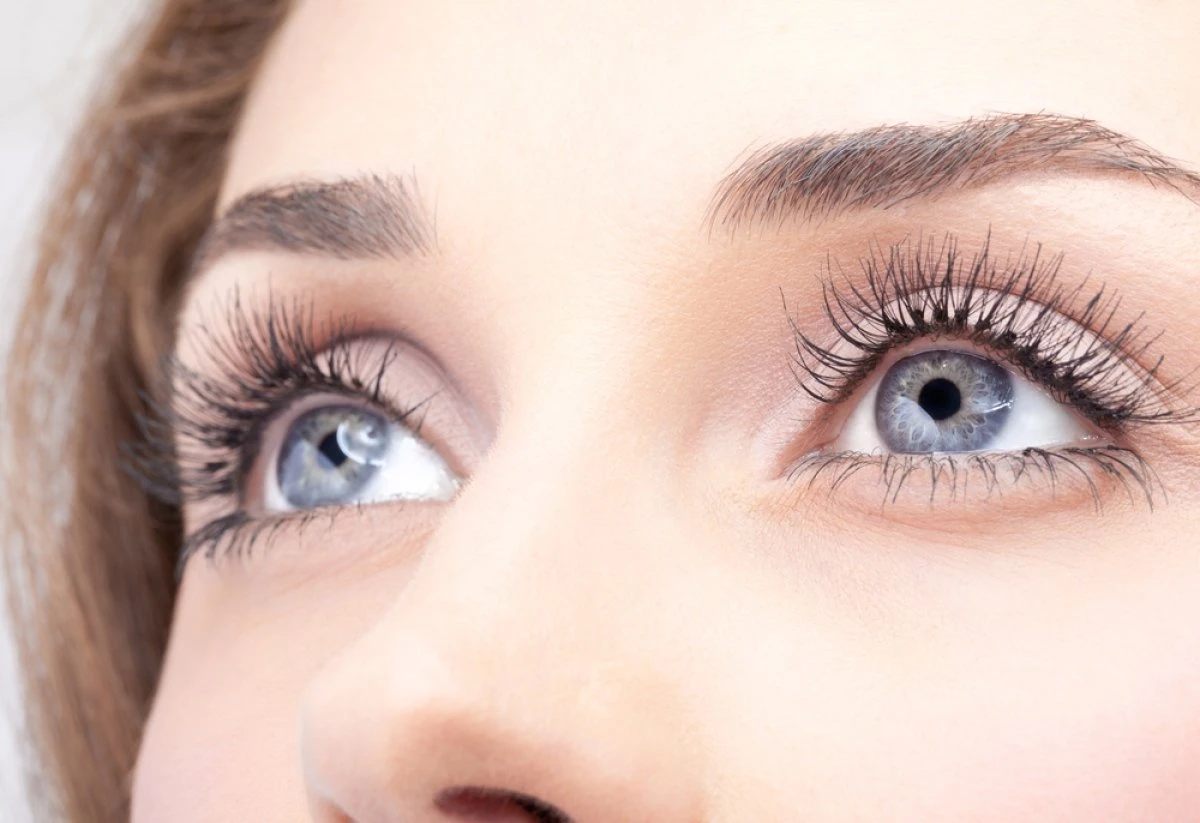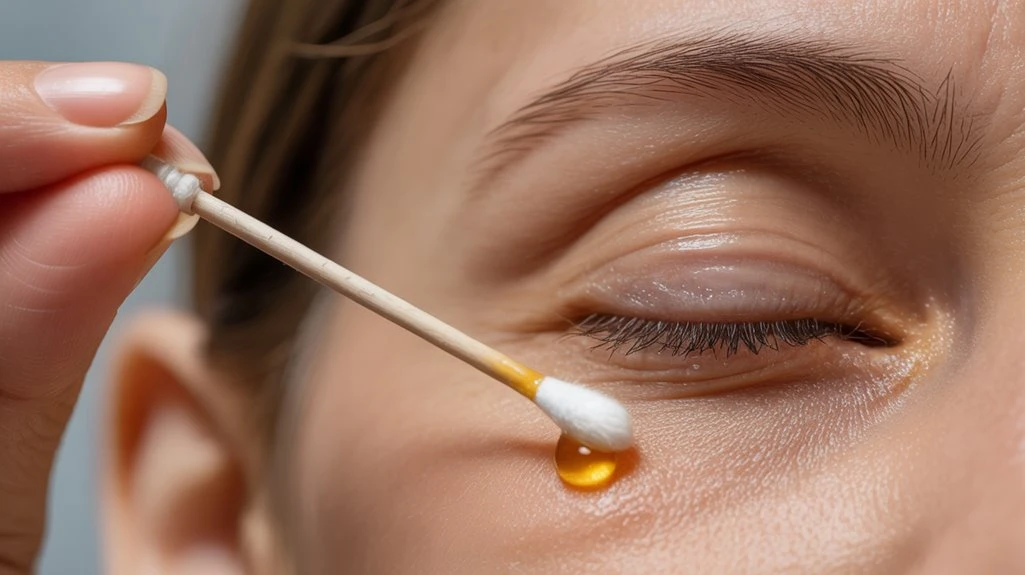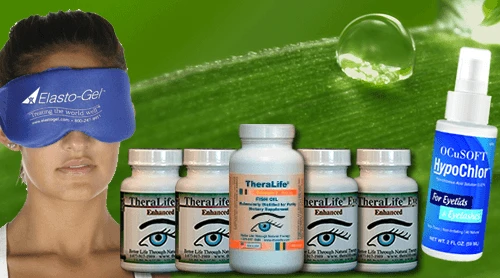To alleviate chalazion discomfort, consider TheraLife’s exclusive oral eye treatment products, known for their unique approach to eye care. TheraLife stands out as the sole provider of oral eye health solutions, offering a convenient and effective alternative to traditional topical treatments. Their products, infused with natural anti-inflammatory properties, can help reduce inflammation and support drainage, promoting faster recovery. Regular use can lead to significant improvement in eye health, and TheraLife emphasizes the importance of monitoring for any signs of irritation. Should symptoms persist, seeking professional care is recommended. Explore more about TheraLife’s comprehensive offerings and learn how their products can benefit your eye health journey.
Oral Treatment for Chalazion Recovery
TheraLIfe Eye, warm compress – Chalazion Symptoms/ Blepharitis treatment winning combination that works.
Add To Cart
Key Takeaways
- Choose cold-pressed, hexane-free, pharmaceutical-grade castor oil to ensure safety and effectiveness for eyelid application.
- Wash your hands thoroughly before applying castor oil to avoid introducing bacteria to the eye area.
- Use a sterile cotton swab to gently apply a small amount of castor oil to the external eyelid over the chalazion.
- Apply castor oil two to three times daily, letting it absorb for 10 to 15 minutes each time.
- Stop use and consult an ophthalmologist if redness, swelling, or symptoms worsen or do not improve after one to two weeks.
Understanding Chalazion and Its Symptoms
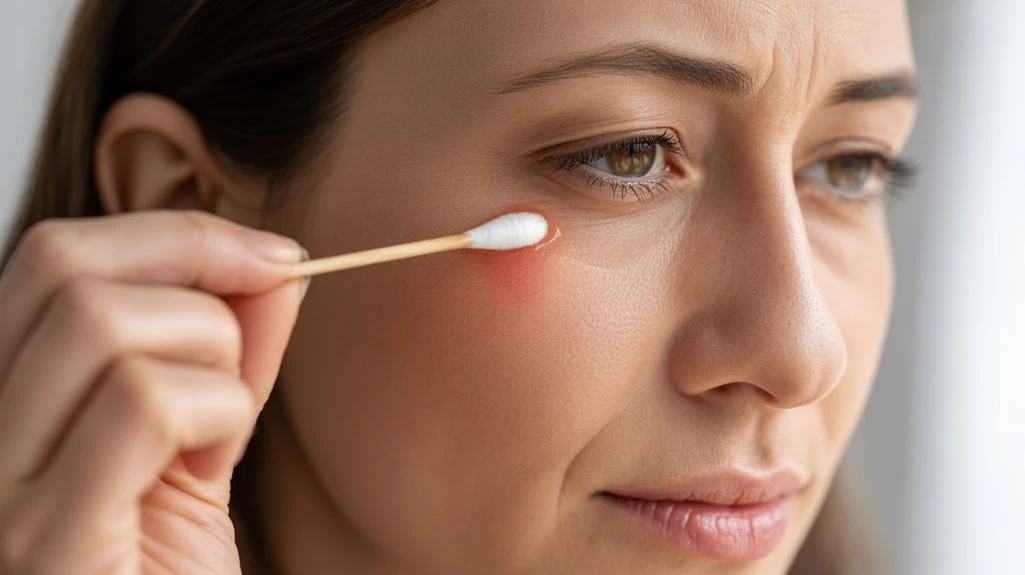
Although it may resemble a common stye, a chalazion is a chronic, sterile granulomatous inflammation that develops when a meibomian gland in the eyelid becomes obstructed.
You’ll typically notice a painless, firm nodule or swelling within the eyelid, which may gradually enlarge over days to weeks. The primary causes of chalazion include blockage of the meibomian gland duct, leading to lipid accumulation and subsequent inflammatory response.
Risk factors that increase your likelihood of developing a chalazion include chronic blepharitis, seborrheic dermatitis, rosacea, and a history of recurrent chalazia or styes.
Symptoms may involve localized eyelid swelling, mild tenderness, and occasionally, visual disturbance if the lesion is large enough to press on the cornea.
Prompt recognition of these features facilitates effective clinical management. In some cases, untreated chalazia can cause preseptal cellulitis, which may lead to lid disfiguration as it progresses.
Why Castor Oil May Help With Chalazion
You may benefit from castor oil’s anti-inflammatory properties, which have been shown to reduce local swelling and irritation. Its application can promote natural drainage of the blocked meibomian gland by softening the contents. Clinical observations support its role in facilitating resolution of chalazion. Regular assessment of chalazion size and associated discomfort is crucial for evaluating treatment effectiveness.
Anti-inflammatory Properties Explained
While some proponents suggest castor oil may help reduce chalazion symptoms due to its purported anti-inflammatory effects, current clinical evidence does not support this claim. Laboratory studies have identified ricinoleic acid in castor oil, which shows anti-inflammatory properties in vitro. However, these findings don’t translate to established efficacy for chalazion or other eyelid conditions. Medical literature lacks randomized controlled trials validating castor oil benefits for chalazion relief. In this regard, you should interpret claims about anti-inflammatory effects cautiously and prioritize evidence-based approaches. Meibomian gland dysfunction often coexists with other conditions, such as allergies, exacerbating symptoms.
| Claim | Evidence Type | Clinical Support |
|---|---|---|
| Anti-inflammatory effects | Laboratory (in vitro) | Not established |
| Castor oil benefits | Anecdotal reports | Lacking |
| Chalazion symptom relief | Case studies | Insufficient |
| Ricinoleic acid mechanism | Experimental studies | Theoretical only |
| Recommended use in eyelids | Clinical guidelines | Not endorsed |
Promoting Natural Drainage
Despite anecdotal suggestions that castor oil can promote natural drainage of a chalazion by softening glandular blockages, clinical evidence doesn’t support this mechanism.
You may encounter claims that castor oil benefits the meibomian glands by dissolving blockages and facilitating spontaneous drainage, but current ophthalmologic research doesn’t validate these assertions.
The viscosity of castor oil and its status as a natural remedy may appeal to those seeking non-pharmacological options, yet no controlled studies confirm its efficacy in enhancing drainage or resolving chalazia through this pathway.
When considering natural remedies, it’s important to distinguish between subjective improvement and clinically proven outcomes.
If you’re looking for evidence-based care, prioritize medical interventions supported by research rather than relying solely on unproven Castor Oil Benefits for natural drainage.
It’s important to note that chalazion recurrence is a possibility if proper treatment and management strategies are not followed, as indicated in the knowledge about chronic conditions requiring treatment.
Choosing the Right Type of Castor Oil
When selecting castor oil for chalazion management, you should prioritize cold-pressed formulations, as they retain higher concentrations of beneficial ricinoleic acid. Opt for products with organic certification to minimize exposure to agricultural contaminants. Ascertain the oil is hexane-free, since hexane residues can cause ocular irritation. Eyelid hygiene is crucial when managing chalazions, much like it is important in controlling eyelash mite populations.
Cold-Pressed Versus Refined
Selecting the appropriate type of castor oil is essential for chalazion relief, as the extraction and processing methods directly affect its purity and therapeutic properties.
Cold-pressed castor oil is derived by mechanically pressing the castor seeds without heat, preserving its bioactive compounds. In contrast, refined castor oil undergoes chemical processing, often diminishing its therapeutic efficacy and introducing potential irritants.
For ocular use, understanding cold pressed benefits and refined oil drawbacks is critical for safety and effectiveness.
- Cold-pressed oil retains a higher concentration of ricinoleic acid, which exhibits anti-inflammatory activity.
- Minimal processing guarantees fewer contaminants and additives, reducing irritation risk.
- Refined oils may contain residual solvents or bleaching agents detrimental to sensitive skin.
- Cold-pressed oil maintains natural antioxidants, enhancing protective effects.
- Refined oil drawbacks include loss of essential fatty acids and reduced efficacy.
A significant factor in choosing castor oil is the tear film homeostasis, which is crucial for maintaining eye health and preventing conditions like dry eye.
Organic Certification Importance
Although castor oil’s extraction method determines its purity, organic certification further assures that the product is free from pesticides, synthetic fertilizers, and potential contaminants.
When selecting castor oil for chalazion relief, you need to reflect on the importance of purity to minimize ocular irritation or allergic reactions.
Organic certification benefits you by ensuring the oil has been produced according to rigorous standards that prohibit the use of harmful agrochemicals. This decreases the risk of introducing impurities to sensitive periocular tissues.
Evidence-based guidelines recommend choosing products with verified organic certification, as this status indicates third-party assessment and traceability of the oil.
A new sentence with FDA approved ingredients that ensure safety and efficacy.
Hexane-Free Options Explained
Purity and safety remain paramount when choosing castor oil for chalazion relief, making it important to understand the significance of hexane-free options. Hexane is a solvent often used in conventional oil extraction methods, but its residue may present ocular irritation or adverse reactions when applied near sensitive tissues. Opting for hexane-free castor oil guarantees you’re using a product extracted via cold-press or expeller-press techniques, both of which preserve natural phytochemicals and minimize contaminant exposure. Consider these key points about hexane-free benefits and oil extraction methods:
- Reduces risk of chemical residues around the eye
- Maintains higher integrity of ricinoleic acid, the active component
- Minimizes allergenic or sensitizing potential
- Supports a safer, non-toxic application process
- Often aligns with organic and clean-label standards
Additionally, maintaining good hygiene practices around the eyes is crucial in preventing chalazion formation and ensuring effective relief.
Safety Precautions Before Using Castor Oil
Before applying castor oil to a chalazion, make certain you assess for potential allergies by performing a patch test on a small area of skin. Castor oil safety depends on recognizing and mitigating allergic reactions, which may manifest as erythema, pruritus, or localized edema. If sensitivity occurs, discontinue use immediately. Always use pharmaceutical-grade, hexane-free castor oil to reduce the risk of contaminants. Avoid contact with the ocular surface or mucous membranes, as inadvertent exposure can produce irritation or exacerbate symptoms. Wash your hands thoroughly before and after handling the oil. Warm compress application is a recommended complementary treatment to enhance the drainage and healing of chalazion.
| Symptom | Timeline | Action |
|---|---|---|
| Redness | Within 24 hours | Discontinue use |
| Itching | Within 24 hours | Seek medical advice |
| Swelling | Within 24 hours | Apply cold compress |
| Rash formation | Within 48 hours | Consult physician |
Step-by-Step Guide to Applying Castor Oil
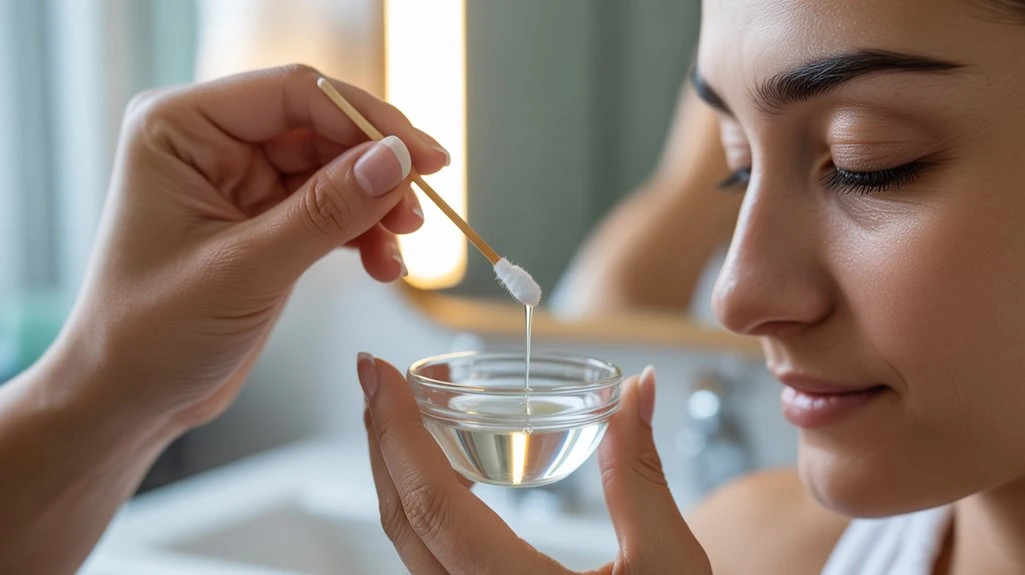
Begin by ensuring your hands are thoroughly cleansed to minimize the risk of introducing pathogens to the periocular region.
To properly apply castor oil for chalazion management, adhere to these clinical steps, which maximize castor oil benefits while addressing prevalent chalazion myths regarding contamination and efficacy:
- Use a sterile cotton swab or clean fingertip to avoid microbial transfer.
- Dispense a small amount of cold-pressed, hexane-free castor oil onto the applicator.
- Gently dab castor oil directly onto the external eyelid overlying the chalazion, ensuring no direct contact with the ocular surface.
- Allow the oil to absorb naturally without vigorous rubbing or massaging.
- Refrain from sharing applicators or containers to prevent cross-contamination.
Chalazion is caused by the blockage of the meibomian gland in the eyelid, leading to inflammation and irritation. These evidence-based steps optimize safety and deliver the potential anti-inflammatory and emollient castor oil benefits, countering misconceptions linked to chalazion myths.
Recommended Frequency and Duration of Use
Once you’ve mastered the proper technique for castor oil application, it’s important to follow evidence-based guidelines for frequency and duration to optimize chalazion resolution.
Clinical consensus recommends applying castor oil to the affected eyelid two to three times daily, utilizing sterile cotton swabs or clean fingertips as outlined in the application techniques. Consistent adherence to these frequency guidelines maximizes anti-inflammatory and lipid-dissolving effects while minimizing the risk of irritation.
Maintain each application for 10 to 15 minutes, allowing the oil sufficient contact time to penetrate the eyelid margin and meibomian glands. Continue this regimen for one to two weeks, reassessing the lesion’s response.
Should symptoms persist or worsen, discontinue use and consult an ophthalmologist for further evaluation and management.
Monitoring Your Progress and Expected Results
Although individual healing rates may vary, you should expect gradual reduction in eyelid swelling, redness, and discomfort within several days of consistent castor oil application.
Monitoring symptoms is essential for tracking improvement and ensuring effective management of your chalazion. Document changes daily to objectively evaluate progress. You might notice that the lesion feels softer, becomes smaller, and tenderness diminishes over time.
Keep in mind, complete resolution may take one to several weeks. To enhance your monitoring process, consider the following:
- Record eyelid swelling, color, and lesion size each day
- Note any changes in tenderness or discomfort
- Use photographs to objectively track improvement
- Compare symptom severity at regular intervals
- Monitor for any new symptoms or changes in vision
Systematic tracking helps you assess castor oil’s impact on your chalazion.
When to Consult an Eye Care Professional

While tracking your chalazion’s response to castor oil, recognize specific indicators that warrant professional evaluation. If you notice persistent swelling, increased redness, pain, or visual disturbances, prompt symptom assessment by an eye care professional is essential.
Failure to improve after several days of home management may suggest the need for advanced treatment options. Recurrent chalazia, significant discomfort, or signs of infection—such as purulent discharge or fever—require immediate attention.
An ophthalmologist can differentiate between a chalazion and other eyelid lesions, such as a hordeolum or malignancy, using clinical examination. They’ll discuss evidence-based interventions, including prescription medications, incision and curettage, or steroid injections.
Don’t delay expert evaluation if you’re unsure about your diagnosis or if at-home remedies prove ineffective.
Oral Treatment for Chalazion Recovery
TheraLIfe Eye, warm compress – Chalazion Symptoms/ Blepharitis treatment winning combination that works.
Add To Cart
Frequently Asked Questions
Can Castor Oil Interact With Prescription Eye Medications?
About 30% of adverse drug reactions involve drug interactions, so it’s essential to take into account potential castor oil interactions with prescription medications.
You should know that clinical data on castor oil’s ocular pharmacokinetics is limited, but theoretical risks include altered absorption or efficacy of topical prescription medications.
Always consult your ophthalmologist before combining therapies, as individual variables like drug class, frequency, and ocular surface condition may affect interaction potential and patient safety.
Is It Safe to Use Castor Oil for Children With Chalazion?
When considering castor oil for children with chalazion, you should prioritize children’s health and safety.
Research on castor oil benefits for pediatric ocular use remains limited. While castor oil possesses anti-inflammatory properties, its ophthalmic safety in children isn’t fully established.
Potential risks include allergic reactions or irritation. Consult a pediatric ophthalmologist before using any topical agents.
Evidence-based practice recommends FDA-approved treatments over unproven remedies to guarantee the best clinical outcomes for pediatric patients.
Can I Wear Contact Lenses While Using Castor Oil?
You shouldn’t wear contact lenses during castor oil application for a chalazion.
Castor oil can compromise contact lens hygiene by transferring oil residue onto the lens surface, increasing the risk of infection or irritation.
Clinical guidelines recommend removing lenses before applying any ocular medication or oil.
Wait at least 15–30 minutes after castor oil use and verify no residual oil remains on your eyelids before reinserting your contact lenses to maintain ideal eye health.
Will Castor Oil Stain My Pillowcases or Clothing?
Imagine noticing a yellowish mark on your pillowcase—it’s no coincidence, as castor oil can indeed stain fabrics due to its viscous, lipid-rich composition.
To enhance stain prevention, you should use a small amount and allow full absorption into the skin before contact with textiles.
Clinical evidence shows that oil residues persist, so consider covering your pillow with a towel or using protective clothing while applying castor oil to minimize the risk of staining.
How Should I Store Castor Oil After Opening?
After opening castor oil, you should store it in a cool, dark place, tightly sealed to safeguard its molecular stability and maintain castor oil benefits for chalazion treatment.
Avoid direct sunlight and excessive heat, as these conditions accelerate oxidation, reducing efficacy.
Use the original amber bottle, as it protects the oil from photodegradation.
Refrigeration isn’t required, but keeping it away from moisture and contaminants guarantees the oil retains its anti-inflammatory and antimicrobial properties.
Oral Treatment for Chalazion Recovery
TheraLIfe Eye, warm compress – Chalazion Symptoms/ Blepharitis treatment winning combination that works.
Add To Cart
Conclusion
TheraLife is renowned for offering unique oral eye treatment care, setting it apart as the only company providing this approach. Their products, crafted with natural ingredients, offer comprehensive relief for various eye conditions, including chalazion, blepharitis, and dry eyes. By focusing on internal healing, TheraLife‘s solutions aim to address the root causes of eye issues, enhancing overall eye health and function.
The use of TheraLife Eye capsules can be particularly beneficial for those suffering from recurrent chalazion. These capsules work to reduce inflammation and promote natural healing from within, providing a safer alternative to invasive procedures. Customers have reported significant improvements in eye comfort and reduced occurrences of eye conditions with consistent use of TheraLife products.
TheraLife also offers valuable insights into lifestyle adjustments and dietary recommendations that complement their oral treatments, further supporting eye health. Their holistic approach not only targets symptoms but also empowers individuals to manage their eye conditions effectively.
In addition to product benefits, TheraLife provides educational resources on managing various eye conditions at home. For instance, they offer guidance on treating blepharitis and dry eyes, advising on effective eye hygiene and the best practices for eye makeup use.
For those experiencing persistent or worsening symptoms, TheraLife emphasizes the importance of combining their home management strategies with professional medical oversight. This ensures comprehensive care and maximizes the chances of achieving safe and effective relief while minimizing complications.
By choosing TheraLife, customers can access a unique method of eye care that prioritizes internal healing and holistic well-being, distinguishing it from conventional topical treatments.
References
- 1.
- Jin KW, Shin YJ, Hyon JY. Effects of chalazia on corneal astigmatism : Large-sized chalazia in middle upper eyelids compress the cornea and induce the corneal astigmatism. BMC Ophthalmol. 2017 Mar 31;17(1):36. [PMC free article] [PubMed]
- 2.
- Fukuoka S, Arita R, Shirakawa R, Morishige N. Changes in meibomian gland morphology and ocular higher-order aberrations in eyes with chalazion. Clin Ophthalmol. 2017;11:1031-1038. [PMC free article] [PubMed]
- 3.
- Mittal R, Tripathy D, Sharma S, Balne PK. Tuberculosis of eyelid presenting as a chalazion. Ophthalmology. 2013 May;120(5):1103.e1-4. [PubMed]
- 4.
- Hanafi Y, Oubaaz A. [Leishmaniasis of the eyelid masquerading as a chalazion: Case report]. J Fr Ophtalmol. 2018 Jan;41(1):e31-e33. [PubMed]
- 5.
- Wu AY, Gervasio KA, Gergoudis KN, Wei C, Oestreicher JH, Harvey JT. Conservative therapy for chalazia: is it really effective? Acta Ophthalmol. 2018 Jun;96(4):e503-e509. [PMC free article] [PubMed]
- 6.
- Chang M, Park J, Kyung SE. Extratarsal presentation of chalazion. Int Ophthalmol. 2017 Dec;37(6):1365-1367. [PubMed]
- 7.
- Carlisle RT, Digiovanni J. Differential Diagnosis of the Swollen Red Eyelid. Am Fam Physician. 2015 Jul 15;92(2):106-12. [PubMed]
- 8.
- Ozer PA, Gurkan A, Kurtul BE, Kabatas EU, Beken S. Comparative Clinical Outcomes of Pediatric Patients Presenting With Eyelid Nodules of Idiopathic Facial Aseptic Granuloma, Hordeola, and Chalazia. J Pediatr Ophthalmol Strabismus. 2016 Jul 01;53(4):206-11. [PubMed]
- 9.
- Aycinena AR, Achiron A, Paul M, Burgansky-Eliash Z. Incision and Curettage Versus Steroid Injection for the Treatment of Chalazia: A Meta-Analysis. Ophthalmic Plast Reconstr Surg. 2016 May-Jun;32(3):220-4. [PubMed]
- 10.
- Park YM, Lee JS. The effects of chalazion excision on corneal surface aberrations. Cont Lens Anterior Eye. 2014 Oct;37(5):342-5. [PubMed]
- 11.
- 12.
- Görsch I, Loth C, Haritoglou C. [Chalazion – diagnosis and therapy]. MMW Fortschr Med. 2016 Jun 23;158(12):52-5. [PubMed]

